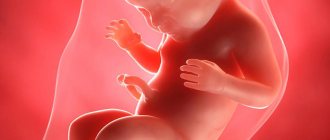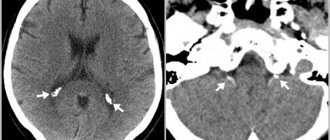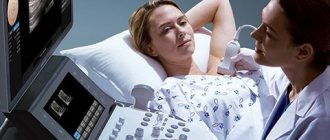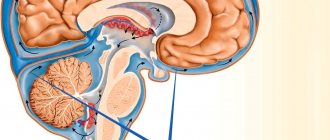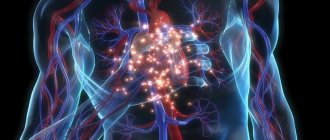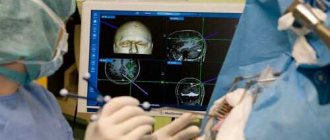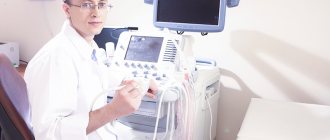The main reasons for the development of CNS HIP:
- anemia in the mother (a decrease in the amount of hemoglobin, which reduces the delivery of oxygen and nutrients to the tissues of the baby’s body) - any chronic diseases and defects: congenital heart defects, lungs of other organs, kidney disease, the presence of diabetes mellitus, which contribute to poor circulation - complications pregnancy and childbirth (gestosis, threat of premature birth, pathology of the placenta and umbilical cord, prematurity and post-term pregnancy, multiple pregnancies, polyhydramnios and oligohydramnios, various anomalies of labor) - fetal diseases (hemolytic disease of the newborn, intrauterine infection, bleeding) Tangible signs of fetal hypoxia mainly are expressed in changes in its motor activity (sudden increase, increased heart rate and movements (movements) of the fetus during acute hypoxia, or a decrease and weakening of them during chronic hypoxia). When a diagnosis of intrauterine fetal hypoxia is made, the expectant mother needs to carry out procedures to identify the causes, followed by comprehensive treatment of their source, with possible hospitalization in a hospital, adherence to bed or home rest and daily routine.
What are the dangers and consequences of PPCNS?
There is an opinion among experts that if the central nervous system of the fetus has been damaged, it cannot be completely restored. But practicing neurologists say the opposite. They say that if the disease is treated correctly and in a timely manner, it is possible to achieve partial or complete restoration of the functions of the nervous system. But even despite such an optimistic forecast, if you look at all possible diseases of a child associated with the nervous system, then 50% of their total number leads to disability, while about 80% of it is allocated to perinatal damage to the central nervous system.
Diagnostics:
It is necessary to conduct an ultrasound examination of the fetus, use cardiotocography (recording of the fetal cardiac activity) and Dopplerometry (study of the blood flow of the vessels of the uterus and umbilical cord of the fetus) with the frequency prescribed by the attending physician. Auscultation (listening) of the fetal heartbeat with a stethoscope is also used. It should be noted that not every pregnancy occurs against the background of the above diseases, complicating intrauterine fetal hypoxia. To prevent the possible occurrence of hypoxia, special attention is paid to its prevention: long walks in the fresh air, mandatory dosed physical activity (gymnastics, exercises, exercises for pregnant women and breathing exercises, swimming, yoga). It is possible to use hyperbaric oxygen therapy (HBO) as prescribed by the attending physician. It must be remembered that treatment must be prescribed by a gynecologist, be comprehensive and take into account an individual approach to each expectant mother.
How is PCNSL treated?
To restore the basic functions of the central nervous system, as well as to reduce the manifestation of neurological symptoms, the baby is prescribed a whole range of medications. Treatment can include, for example, nootropic drugs that can restore trophic processes in the brain - piracetam, Cerebrolysin, Cortexin, pantocalcin, solcoseryl and many others. In order to stimulate general reactivity, a newborn child is given a course of therapeutic massage, special gymnastics, and, if necessary, a set of physiotherapeutic procedures (for example, electrophoresis and microcurrents).
If parents detect at least one of the signs of central nervous system damage, they should immediately consult a doctor. Do not forget that the development of each child is an individual process. Such individual characteristics of a newborn child in each specific case play an important role in the process of restoring the functions of higher nervous activity.
Early symptoms that should be addressed to a pediatric neurologist
- sluggish breastfeeding, choking during feeding, leakage of milk through the baby's nose - weak cry of the child, nasal or hoarse voice - frequent regurgitation and insufficient weight gain - decreased motor activity of the child, drowsiness, lethargy or severe anxiety - trembling of the chin, upper and/or or lower extremities, frequent startlings - difficulty falling asleep, frequent awakenings during sleep - throwing back the head - slowing or rapid increase in head circumference - low (flabby muscles) or high tone of the muscles of the limbs and torso - decreased activity of movements of the arm or leg on any side , limited hip separation or the presence of a “frog” position with pronounced hip separation, unusual position of the child - strabismus, torticollis - birth of a child by caesarean section, in breech presentation, with an anomaly of labor or with the use of obstetric forceps, extrusion, with the umbilical cord entwined around the neck - prematurity of the child - presence of convulsions during childbirth or in the postpartum period
Late symptoms of birth trauma
There are cases when at birth a baby has minimal impairments, but years later, under the influence of certain stresses - physical, mental, emotional - neurological impairments manifest themselves with varying degrees of severity. These are the so-called late manifestations of birth trauma. Among them: - decreased muscle tone (flexibility), which is so often an additional advantage when playing sports. Often such children are gladly accepted into sports and rhythmic gymnastics sections and choreographic clubs. But most of them cannot stand the physical activity that takes place in these sections. - decreased visual acuity, the presence of asymmetry of the shoulder girdle, angles of the shoulder blades, curvature of the spine, stoop - signs of a possible birth injury of the cervical spine - headaches, dizziness
If you have the above complaints, do not delay your visit to a pediatric neurologist! The specialist will prescribe certain examinations, a course of treatment and will definitely help you!
Perinatal lesions of the central nervous system
What are perinatal lesions of the central nervous system?
Perinatal lesions of the central nervous system (CNS) is a general term for suffering of the nervous system in newborn children caused by various causes.
How common are perinatal lesions of the central nervous system?
From 5 to 55% of children in the first year of life receive this diagnosis, since this number sometimes includes children with mild transient disorders of the nervous system. Severe forms of perinatal CNS lesions are observed in 1.5–10% of full-term and 60–70% of premature infants.
Why do perinatal lesions of the central nervous system occur?
The main cause of perinatal damage to the central nervous system in the fetus and newborn is hypoxia (oxygen deficiency), which occurs under the influence of various factors. Unfavorable conditions for the development of the fetus in the womb can be established long before pregnancy due to various diseases in a teenage girl, the expectant mother. Infectious and non-infectious diseases, hormonal disorders, bad habits, and occupational hazards during pregnancy cause increased hypoxia in the unborn child. Previous abortions lead to disruption of blood flow between mother and fetus and, consequently, to intrauterine hypoxia. Sexually transmitted infections (chlamydia, herpes, syphilis) play an important role in the development of perinatal lesions of the central nervous system. The cause of acute asphyxia during childbirth can be various disturbances in the normal course of labor, rapid or protracted labor, and incorrect position of the umbilical cord loops. Mechanical trauma to a child less often leads to perinatal damage to the central nervous system (especially the brain). The risk of child injury and acute asphyxia increases if childbirth takes place outside a medical facility, including water birth. In premature babies, due to their immaturity, perinatal damage to the central nervous system is observed more often.
Are perinatal lesions of the central nervous system dangerous?
Severe perinatal brain damage (including intracranial hemorrhage, severe cerebral ischemia) pose a real threat to the life and health of the child, even with timely, highly qualified medical care in a perinatal center. Moderate and mild forms of brain damage do not pose an immediate threat to life, but they can cause mental disorders and the development of motor activity in a child.
How do perinatal lesions of the central nervous system manifest themselves?
Features of disorders in perinatal damage to the central nervous system depend on the nature of the brain damage (hemorrhage in various brain structures, ischemia, infectious lesions), their severity, the degree of maturity of the child, and the stage of the disease.
For example, in premature infants with severe brain damage, general deep depression with respiratory failure, sometimes with short-term convulsions, predominates. In full-term newborns, both depression and increased excitability (motor restlessness, irritated cry), and prolonged convulsions are possible. By the end of the first month of a child’s life, lethargy and apathy can be replaced by increased excitability, muscle tone increases (muscles are too tense), and abnormal position of the limbs develops (clubfoot, etc.). In addition, it is possible to develop internal or external dropsy of the brain (hydrocephalus). The manifestations of spinal cord injury depend on the location and extent of the injury. For example, when the cervical spinal cord or nerve plexuses are damaged, “obstetric paralysis” occurs—sagging or immobility of the arm on the affected side.
With moderate brain damage, vegetative-visceral manifestations may predominate: persistent regurgitation, delayed or frequent bowel movements, bloating, thermoregulation disorders (the body's reaction to heat and cold), pallor and marbling of the skin, lability of the cardiovascular and respiratory systems, etc.
In children with severe perinatal damage to the central nervous system, from the end of the first month of life, a delay in the development of the psyche and movements is noted: the reaction to communication is sluggish, a monotonous cry (not emotionally colored). Possible early (at 3–4 months) formation of persistent motor disorders similar to cerebral palsy.
It should be noted that moderate (and sometimes severe) lesions of the central nervous system can be asymptomatic and appear at 2–3 months of life. Parents should be alerted to insufficient physical activity or its excess, attacks of causeless restlessness, lack of a clear reaction to sounds and visual stimuli in a full-term baby older than 2 weeks, as well as a stable (habitual) position of the body with a turn to one side, crossing the legs in a vertical position, support “on tiptoes”, persistent throwing back of the head, bulging or pulsating fontanel, separation of cranial sutures, habitual squinting or rolling of the eyes (the “setting sun” symptom).
How is perinatal damage to the central nervous system diagnosed?
The diagnosis is based on medical examination data, anamnestic data and is confirmed by instrumental studies. Ultrasound examination (ultrasound) of the brain with assessment of the condition of its blood vessels (Dopplerography) is of great importance. If necessary, use X-ray examination of the skull, spine, computed tomography (CT), magnetic resonance imaging (MRI).
What methods of treatment and prevention of perinatal damage to the central nervous system exist?
In the acute period of severe perinatal brain damage, treatment is carried out in the neonatal intensive care unit. First of all, disturbances in the functioning of the respiratory, cardiovascular system and metabolic disorders are eliminated, seizures are eliminated (if necessary, artificial ventilation of the lungs, intravenous infusions, and parenteral nutrition are performed). Next, the newborns are transferred to a special department, where individual treatment is continued depending on the nature and severity of the brain damage: anticonvulsants are used, in case of developing hydrocephalus - dehydration drugs, as well as drugs that stimulate the growth of capillaries and improve the nutrition of damaged brain tissue. These same drugs, as prescribed by a neurologist, can be used throughout the first year of life in repeated courses. For moderate and especially mild lesions of the central nervous system, non-drug therapy is mainly used.
In the recovery period (from the end of the first year of life), non-drug rehabilitation methods are of decisive importance: therapeutic massage and gymnastics, exercises in water, physiotherapy, pedagogical methods of music therapy (healing and treating the body with the help of music).
Prevention of perinatal brain damage can be primary and secondary
Primary prevention involves improving the health of adolescents (future parents), routine monitoring of pregnant women in order to identify pregnancy disorders as early as possible, and competent obstetric care (including planned caesarean section if there is a high risk of birth trauma).
Secondary prevention is the prevention of adverse consequences of perinatal pathology for the child, carrying out comprehensive treatment and effectively restoring his health.
Head of the neuro-orthopedic department of the TANAR Family Clinic Gulfiya Tyafikovna Usmanova
